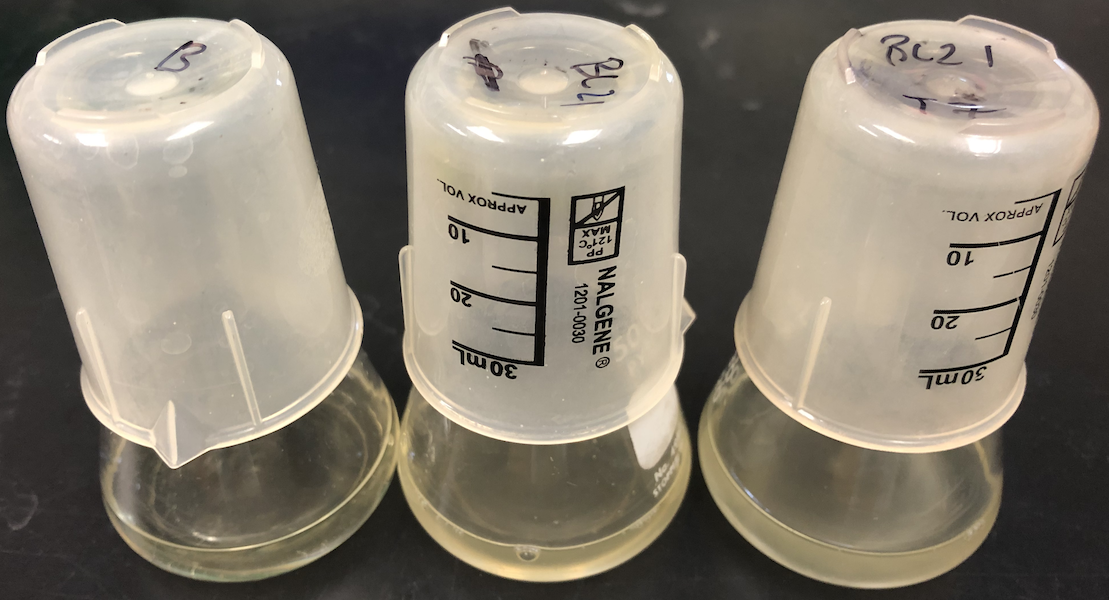Phage Lysate Preparation
We have used this protocol with phages T4, T5, T6 and T7. The general procedure should work with most lytic E. coli phages (although lysis times and final titers may differ). See the variants section for some ways to modify it for other hosts/phages.Materials
- Overnight culture of a permissive E. coli host (see the table below)
- Frozen stock of phage (or plate with fresh plaques)
- LB-Miller Media (w/antibiotics or supplements appropriate for host E. coli)
- 50 mL flasks (recommended) or test tubes
- 15 mL Falcon tubes
- Shaking incubator at appropriate temperature (37° or 30°)
- Chloroform (Safety: All work with chloroform should be done in a fume hood with gloves, a lab coat, and eye protection.)
| phage | host strain | phage stock | notes |
|---|---|---|---|
| T4 | REL606 | JEB1010 | |
| T5 | REL373 | JEB1011 | |
| T6 | REL373* | JEB1012 | *REL606 is resistant to phage T6 |
| T7 | BL21 | JEB1313 | |
| T7Δ2 | BL21 | JEB1314 | |
| λ-vir (cI26) | REL606 | JEB1066 | add 0.2% maltose to LB when growing host; store phage in suspension medium (SM) or LB + 10 mM MgSO4 † |
| P1 | REL606 | JEB1251 | add 0.2% glucose and 5 mM CaCl to LB when growing host ¶ |
| TLS | REL606 | JEB1499 |
Procedure

T7 lysate showing small amount of chloroform that has settled to the bottom of the tube.
- Prepare overnight culture of permissive host
- Dilute 1 mL of overnight culture into 10 mL fresh media (1:10 dilution) for each phage lysate. Include an extra dilution as a no-phage control for turbidity comparison w/ lysed cultures
- Grow these cultures for 30-60 min (OD ~0.2)
- It's highly recommended that you start a no-phage control at the same time (i.e., an extra flask of diluted host w/no phage added) for turbidity comparison w/ lysed cultures
- Pick a plaque from a fresh overnight plate (for clonal lysate) or scrape frozen stock with a sterile toothpick or pipet tip. Ideally, you are aiming for an inoculum of ~106 PFU.
- Shake @ ~200 RPM at the appropriate temperature until culture lyses completely
- It should have little or no turbidity compared to the no-phage control. You will usually see bits of aggregated cell debris also.
- Add 50-100 µL of chloroform and vortex
- Spin 5min @ 5000 × g (RCF)
- Transfer lysate (supernatant) to a clean tube
- For long-term storage @ 4°C, add 50 µL chloroform to prevent bacterial growth
- For long-term storage @ -80°C, add glycerol to 20% and mix well
- Determine phage titer Protocol: Measuring Phage Titers
Expected Results
If you are starting from a freezer stock or old lysate, you may need to perform this procedure multiple times to get the titer of your lysate up. Expected ranges of "good" lysate that can be achieved with this procedure should be in these ranges:- T4 lysates (1010-1012 PFU/ml)
- T5 and T6 lysates (107-109 PFU/ml)
- T7 lysates (???? PFU/ml)
 |
Blank (left), E. coli BL21 (center) and E. coli BL21 + Phage T7 (right) immediately after phage is added from a high-titer lysate. |
 |
Blank (left), E. coli BL21 (center) and E. coli BL21 + Phage T7 (right) 3 hours later showing that lysis has occurred in the flask with phage but cell density has increased in the negative control with only E. coli |
Variants
nsAA evolution strains
- Use the host strain MJH116(Amberless) transformed with a plasmid encoding the desired nsAA-aaRS.
- Supplement media with antibiotics and 250μM nsAA.
- Cultures of this strain may need up to 24h to reach saturation.
- Some evolved strains may lyse stochastically. It may help to set up 8-10 lysis cultures and use the clearest one.
Sources
Elements of this protocol were adapted from the Lenski Lab Phage-pharming Protocol Brendan Bohannan and Neerja Hajela. Barrick Lab > ProtocolList > ProtocolsPhageAdsorptionRate > ProtocolPhageLysate
Topic revision: r8 - 2022-08-03 - 14:17:36 - Main.JeffreyBarrick